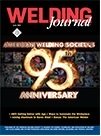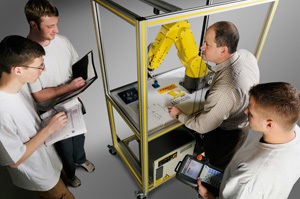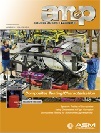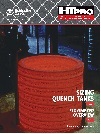| Back to Back Issues Page | ||||||||||
 |
||||||||||
|
PWL#131 - Automation Myths, Cooling RSW, Spot welding Al to Mg, Advanced Testing, HT Pro July 01, 2014 |
||||||||||
| We hope you will find this Letter interesting and useful. Let us know what you think of it.
PWL#131 A reality check on Automation Myths, Cooling a Group of Resistance Spot Welders, Filler Metal for Dissimilar (Al-Mg) Resistance Spot Welding, Modern Mechanical Testing for Advanced Requirements, The Heat Treating Professional Publication, Laser Drilling, Leak Testing and much more...
The Mid June 2014 Issue of Practical Welding Letter, Bulletin 97, introducing Resources on Welding Jigs and Fixtures was not distributed by e-mail but is available at Bulletin 97 and from the Welding Resources Page.
DON'T USE REPLY to send your messages! Use the Contact Us form instead. This publication brings to the readers practical answers to welding problems in an informal setting designed to be helpful and informative. We actively seek feedback to make it ever more useful and up to date. We encourage you to comment and to contribute your experience, if you think it may be useful to your fellow readers. You are urged to pass-along this publication to your friends, if you like it, and if you think it may help them. If
you received this from a friend and if you like what you read, please subscribe free of charge and you will also receive a bonus book on Practical HARDNESS TESTING Made Simple. The addresses reported hereafter were live and correct at the time of their publication. There is no guarantee that they will always be so, because they are administered by the sources themselves and are under their control. Note: References to articles or other documents are given here in If they are URL's (Uniform Resource Locator), which is the analogue of an address, they begin with "http://..." or "www.". These are not live and must be copied and pasted entirely into the browser (after having been selected with the mouse or otherwise). If they are long they may be displayed in two or more lines. In that case one has to care that the URL be copied completely in a single line without any space, and Enter. If the information is important to you as we hope, you may save the selected pages in a suitable folder on your Computer for easy reference. You are welcome to forward this page to those of your friends who may profit of this information.
(Sponsored Links)
1 - Introduction 2 - Article - A reality check on Automation Myths 3 - How to do it well: Cooling a Group of Resistance Spot Welders 4 - Filler Metal for Dissimilar Resistance Spot Welding 5 - Online Press: recent Welding related Articles 6 - Terms and Definitions Reminder 7 - Article: Modern Testing for Advanced Requirements 8 - Site Updating: Laser Drilling (R), Leak Testing (R), 9 - Short Items 10 - Explorations: beyond the Welder 11 - Contributions: The Heat Treating Professional 12 - Testimonials 13 - Correspondence: a few Comments 14 - Bulletin Board
2 - Article - A reality check on Automation Myths
The worries pointed at in the article published in the June 2014 issue of the Welding Journal at page 68, and called Myths, are serious considerations that need objective study. It would be a mistake to disregard them as exaggerated cares. It would also be an error to let them paralyze any thought of change and improvement. All the preconceptions listed in the article must be addressed without bias. It is probably easier to confront a definite situation, referring to an objective work load that cannot be met satisfactorily with existing facilities and workforce. The difficulty in recruiting expert welders or in training new apprentices must be taken into account and can weigh heavily on the decisions. One should know the quantities to be processed and the size of the batches, together with the total time needed for the production of a meaningful lot at the present costs. The economic justification for the introduction of robotic cells depends on the comparison of the anticipated production increase with total cost of its implementation, including learning and familiarizing. The study of similar applications realized by other manufacturers may be suggested by suppliers who have positive experience of successful applications. Industry recognizes that robotic applications expand at accelerated pace and that the cost of basic components decreases with increasing volume and experience. Equipment providers, like the author of the above article, quote their customers that reported increased production with decreasing number of welders, freeing them to attend to other jobs previously neglected. The article points out that not every welding job can be successfully automated. But those which can, contribute to improved productivity and help raise the skill of the workers for their own benefit and for society at large. Readers with pressing production needs might find interest in reading the original article pointed at above.
From:
3 - How to do it well: Cooling a Group of Resistance Spot Welders A correspondent, a Maintenance Supervisor, sent this question: Looking back into the collection of past issues of this publication, we found an article on Proper Water Cooling of Spot Welding Electrodes, published (3) in issue 87 of our Practical Welding Letter for November 2010. There the following article is reported: Influence of water temperature and flow on Electrode Life, from
The following quotation can be found in the first page, under Background: The Resistance Welding Manufacturing Alliance (RWMA) welding handbook notes the importance of water cooling "to maintain the mechanical and physical properties..." of the electrode. The section continues, "...the cooling water flow rate should be a minimum of 1-1/2 gal/min per tip and the incoming water temperature should not exceed 50°F. To improve "what seems to be very poor water flow", the Maintenance Supervisor should probably check the whole cooling system to remove hindrances and to verify that the incoming water temperature does not exceed 50°F (10°C). On the same subject see the last entry in this issue, Section 5, further down this page.
4 - Filler Metal for Dissimilar Resistance Spot Welding
It is known that automakers strive to reduce vehicle weight by adopting light metals like aluminum and magnesium in auto body construction. Spot welding is a well known process used successfully for car mass production. However using it for joining the dissimilar combination of these two metals was generally unsuccessful because of the creation of hard and brittle intermetallic The article published in the Welding Research supplement of the June 2014 issue of the Welding Journal at page 225-s reports on an investigation that used Zinc foil and zinc coated steel interlayer as filler for resistance spot welding of the said dissimilar metals combination. The abstract indicates that strength requirements of AWS Standard D17.2 could not be met when a Zn foil interlayer was used. It should be noted that this Specification was used for reference. D17.2/D17.2M:2013, In fact automotive fabrication may be subject to different requirements. However, acceptable joint strengths were achieved using a Zn coated steel interlayer, since the steel remains solid and can successfully keep Al and Mg from mixing. An ultrathin FeAl layer present at the Zn coating interface of the steel interlayer promoted metallurgical bonding at both Al and Mg alloy interfaces. From the Conclusions of the article we learn the following facts. Welds made with Zncoated steel inter layers met the strength requirements of the AWS standard. During tensile shear testing, Failure average peak load reached 74% of the strength of comparable AZ31B similar resistance spot welds of the same size. The welds made with welding currents of 28 kA and higher met the strength requirements of the AWS D17.2 standard. Similar joining mechanisms took place at the Al/steel and Mg/steel interfaces. The joint area on both Al and Mg sides can be divided into three regions from the center to the edge: weld brazing of molten metal, solid-state welding, and soldering of Al (or Mg) to steel via the Zn-rich filler metal. In the fusion nugget area, Al was joined to steel by formation of a continuous Fe-Al intermetallic compound layer with a maximum thickness of 1.3 µm. Mg was joined to steel mainly through the ultrathin Fe-Al intermetallic layer that was prefabricated on the steel surface during the galvanizing process. Interested readers are urged to seek the said article for a complete exposition of the research. 5 - Online Press: recent Welding related Articles Standards commonly used in the UK joining industry: Health and Safety The Welding Handbook (552 pages) Resistance welding - European Aluminium Association (19 pages) RWMA MEMBER QUICK
SEARCH Chapter 32 - Closed Recirculating Cooling Systems
6 - Terms and Definitions Reminder Please find hereafter a Reminder Overview of Weld Discontinuities Cracks or fissures are fracture type discontinuities that tend to propagate under stress, characterized by a sharp tip opening and a high ratio of length to opening displacement. They are the most damaging and insidious of the defects. Therefore cracks should never be tolerated in any structure. Indeed they are most likely conducive to fracture because of crack propagation under stress. Defect is a discontinuity that makes an inspected item rejectable. It is declared unsuitable to perform its functions within the
acceptable conditions of safety and stability specified in the standards established by design. Discontinuity is defined as an interruption of the typical structure of a material, such a lack of homogeneity in its mechanical, metallurgical or physical characteristics. Fracture is the separation or fragmentation of a solid body into two or more parts under the action of stress. Ductile fracture is characterized by appreciable plastic deformation prior to and during the propagation of the crack. Brittle Fracture in metals is characterized by a rapid rate of crack propagation with no gross plastic deformation and very little microdeformation. Inclusion denotes entrapped foreign material like slag, flux, oxides or extraneous metals like tungsten. Some may be present in the base metal if insufficiently purified in the original manufacturing processes. Inclusions are impurities generally detrimental to physical, mechanical, electrical, and aesthetic properties. Incomplete Fusion is a discontinuity in which fusion did not occur completely, leaving original base metal surfaces of the joint partially unmelted. Incomplete Joint Penetration is present in a groove weld in which the weld metal does not extend through the joint whole thickness. Overlap in fusion welding is the protrusion of unfused (unconnected to base metal) weld metal beyond the weld toe or weld root. In Resistance Seam Welding it the portion of the preceding weld nugget remelted by the following weld. Porosity is a discontinuity consisting in the presence of voids or cavities of various shape and dimensions, due to the liberation of gases (because of their reduced solubility into molten metal during cooling)(or to shrinkage of molten metal) and their entrapment upon solidification of molten metal or during deposition of thermal sprayed material. Undercut is a groove melted in the base metal near the weld toe (border) and left unfilled. Download and see also:
7 - Article: Modern Testing for Advanced Requirements
In the June 2014 issue of Advanced Materials and Processes (AM&P), an ASM International publication, two articles took our attention. The first one, at page 17, reports on innovations in dynamic testing of composite materials. It is pointed out that there is limited consensus on the requirements to be assured in composite materials for demanding applications, and that a vast collection of special fixtures has to be maintained, to allow testing per several applicable international and industry standards. The article remarks the interesting observation that the wind exploitation industry for energy generation is not bound to rigid existing specification and has great interest in developing new Composite materials for demanding applications. Because of their needs, major manufacturers adopted fatigue testing as a key factor in the evaluation of new composite materials. High levels of elastic strain are acceptable in wind turbine blades: design life and cost should find a proper equilibrium to reach economic advantage. Different forms of fatigue testing were explored, requiring special grips and suitable testing machines capability. Fundamental differences from the practice with metal specimens exist that complicate both setup and conduct of fatigue testing in composite material. In particular internal heating influences the results and needs special thermographic analysis methods to understand failure modes. Slow and delicate testing risks to extend testing duration beyond acceptable limits. High strain rate testing of composites presents its own difficulties, as well as precise load measuring and data acquisition. High speed digital cameras and post processing of collected images is more expensive and more informative. Newer methods of investigation like thermoelastic stress analysis (TSA) are being developed, using cameras with much higher sensitivity. The article points out that these new methods are mainly academic, but practical applications will probably follow to study damage evolution. Dynamic performance of larger commercial moving structures must be studied for assuring safety in use. Also the second article, titled The Role of Materials Testing in Vehicle Lightweighting, at page 22 of the same publication, deals with new testing requirements for the complex mixed material systems whose use is demanded for cars with lighter weight and improved performance. Carbon fiber-reinforced plastics (CFRPs) offer high strength with low weight, but require costly technology investments. Joining dissimilar materials is especially challenging. Strict requirements for process application like temperature and adhesive thickness uniformity must be controlled and the quality of manufactured items must be assured. New testing machines and high throughput test methods are being developed for both research and quality control. These include rapid test and positioning speeds, integrated adaptive control with automatic setting of all control parameters, sophisticated strain-rate control, and online compensation for changes in specimen properties. For keeping informed with newer mechanical testing techniques, readers are urged to seek the original publication pointed at above.
8 - Site Updating: Laser Drilling (R), Leak Testing (R), Resources on Welding Jigs and Fixtures The pages of this Month that were revised and updated refer to two processes that were developed long ago. Laser Drilling finds many applications on a wide range of materials, metallic and non, usually on thin sheets. It is a non contact application, totally machine controlled, that needs no human skill except for setup. It is quite rapid, capable of very high output. Specialized shops may perform these operations upon request, as the requirements can easily be programmed. Leak Testing is done on every fluid container or conveyer. Many types are available, depending on sensitivity requirements and on the nature of the fluids involved. For periodic or occasional special requirements, the service may be obtained from subcontractors. Those who need these tests would do well by understanding the basic types and their characteristics, by clicking on the above link. The new mid month Bulletin 97 shows a list of Resources on Welding Jigs and Fixtures, that may come handy when dealing with these subjects. While looking for information in this website, readers can browse the Site Map for main subject pages, the Welding Topics page for PWL Articles, and the Welding Resources page for lists of Online Links to rich sources of knowledge. Comments, questions and feedback are welcomed. Use the Contact Us Form.
9 - Short Items
9.1 - Preferred Orientation is a condition of a polycrystalline aggregate in which the crystal orientations are not random, but rather exhibit a tendency for alignment with a specific direction in the bulk material, commonly related to the direction of working. 9.2 - Recalescence is (1) the increase in temperature that occurs after undercooling, because the rate of liberation of heat during transformation of a material exceeds the rate of dissipation of heat. Also (2) a phenomenon, associated with the transformation of gamma iron to alpha iron on cooling (supercooling) of iron or steel, that is revealed by the brightening (reglowing) of the metal surface owing to the sudden increase in temperature caused by the fast liberation of the latent heat of transformation. 9.3 - Stress Raisers are design features (such as sharp corners, sudden section change etc.) or mechanical defects (such as notches) that act to intensify the stress at these locations. 9.4 - Thermochemical Treatment is a Heat treatment for steels carried out in a medium suitably chosen to produce a change in the chemical composition of the object surface by exchange with the medium. 9.5 - White Rust is Zinc oxide or the powder product of corrosion of zinc or zinc-coated surfaces. 9.6 - Yellow Brass is the name sometimes used in reference to the 65Cu-35Zn type of brass. 10 - Explorations: beyond the Welder Europe on Track for 2020 Energy Efficiency Goal Neandertal Lineage Began in a Game of Thrones World Telescope Will Search for Spacecraft's Post-Pluto Target Drones Bring Fight and Flight to Battle against Poachers The New Environmentalism Will Lead Us to Disaster
11 - Contributions: The Heat Treating Professional
The recent brochure called HT Pro (15 pages), a publication of the ASM Heat Treating Society (HTS), is included in the June 2014 issue of Advanced Materials and Processes (AM&P), published by ASM International. An Initiative intended to study and improve the Service Life of Furnace Materials is presented. It is a Project running at the Worcester Polytechnic Institute (WPI), under the Center for Heat Treating Excellence (CHTE). Different materials and coatings are being assessed for their resistance to service conditions in real furnaces for long times and are examined at intervals to determine the damage and their remaining life. The results of this initiative are anticipated to open the way to reduction in maintenance costs. An interesting article follows, describing the basics of sizing quench tanks for immersion quenching. It offers the theory for calculation of the total heat given up by the quenched metal, and a methodology for determining the temperature-control system required. Typical values of the intervening factors are provided, together with rules of thumb for approximate evaluations of tank dimensions and of quenchant quantities required. The necessity of cooling the heated up quenchant is stressed for assuring repeated quenching operations without overheating. A numerical example with proposed starting data may help in following the calculation and the reasoning behind it. The quenchant described, their characteristics and accepted operational limit are explained, with some discussion on their different behavior. There is an explanation of the System temperature control, for both heating and cooling as necessary. Heat exchangers are described, with an example of their sizing needed to recover the heat within one quench cycle. Then an article from a commercial firm introduces an instrument performing carbon potential analysis for the control of atmospheres in carburizing furnaces (No endorsement or recommendation intended). The working principle and the usage are described, including the need for calibration. The test requires that a calibrated steel wire coil of known composition be introduced in the furnace and soaked in the carbon-containing atmosphere for a given time (about 30 to 40 minutes depending on temperature), ideally until equilibrium in carbon content is achieved. It is then removed from the furnace and cooled before being introduced into the instrument that measures electrical characteristics and outputs the calculated carbon potential. The specific instrument described in the article is designed to provide results within 0.03% of the carbon in an atmosphere containing 0.1 to 1.3% carbon. The last article of the brochure explains the operational principles of several flowmeters. The precise knowledge of the measured values is an increasingly important part of quality control systems. It explains that the most important flowmeter selection criteria in heat treating applications include reliability, accuracy, ruggedness, ease of calibration and of maintenance. First they are divided into volumetric or mass flow measuring devices. The different types are first listed and then described. A useful Table summarizes the types, the operating principle, the manufacturers and typical indicative characteristics. Readers interested in Heat Treating are urged to download the brochure at the following link, and to review the articles summarized here above.
12 - Testimonials Date: 05 Jun 2014, 09:58:17 PM On Thu Jun 05 21:57:17 2014, the following results were submitted from the Name: Kevin Gamble Date: 07 Jun 2014, 11:14:55 AM
On Sat Jun 14 06:41:58 2014, the following results were submitted from the Name: Jamal Nataj Hi Elia
13 - Correspondence: a few Comments 13.1 - I am still surprised (although I should not be) when I receive a message that is not a query nor a comment nor a feedback. Examples: "We are a MEP based company,having projects related to HVAC activities."[end of message] or "welding extrays"[end of message] What can I do short of asking to explain what they want? And even then... 13.2 - I usually request, after my answers, that correspondents fill a short questionnaire, to inform me if my input was understood and useful. I seldom get any reactions at all. To obviate this regrettable behavior, I think of introducing the request of a small fee ($ 10) to be paid to me just to get my answer. I would appreciate readers comments and feedback.
14 - Bulletin Board 14.1 - Quality Control of Aluminium and Copper Laser-Welded Assemblies 14.2 - Heat Treatment Conference 14.3 -
Additive Manufacturing Conference 14.4 - MS&T 14 - Materials Science & Technology 2014 14.5 - Sheet Metal Welding Conference XVI 14.6 - FABTECH 2014
Watch the Video: and also:

BUILT BY: Click on this Logo NOW! 
Copyright (©) 2014, by Elia E. Levi and
See you next time...
|
||||||||||
| Back to Back Issues Page |




